Lyons W.C. (ed.). Standard handbook of petroleum and natural gas engineering.2001- Volume 1
Подождите немного. Документ загружается.

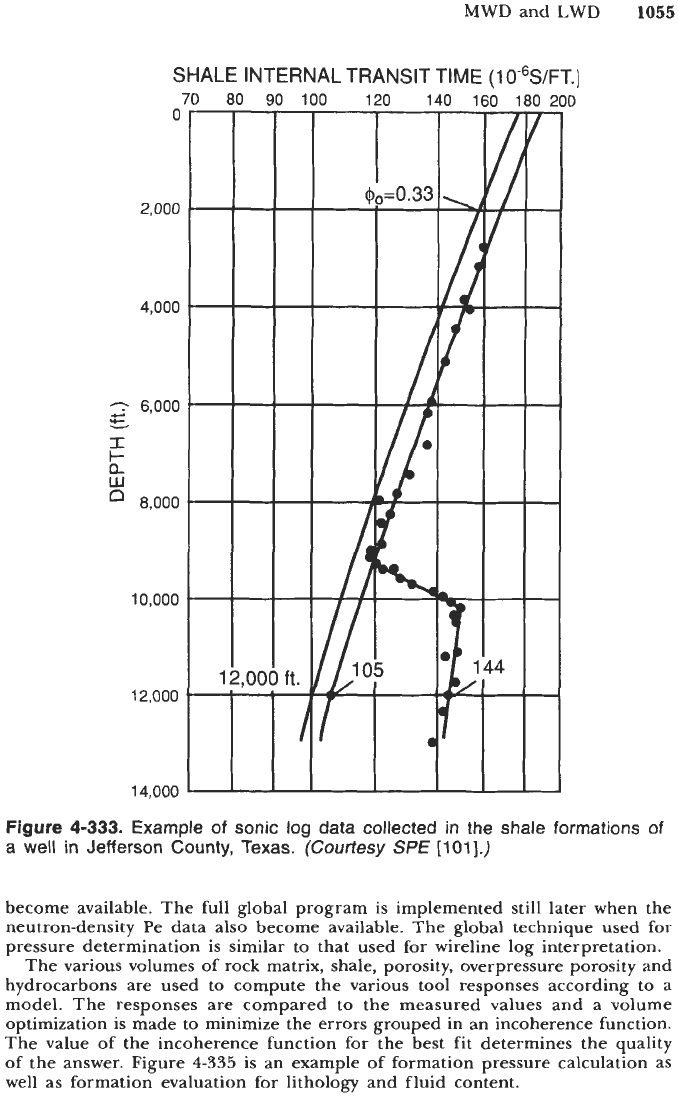
MWD
and
LWD
1055
SHALE INTERNAL TRANSIT TIME (IO-'S/FT.)
1
80
90
100 120 140 160 180 200
0
2,000
4.000
h
6,000
=
I
t-
n
W
c
8,000
10,000
12.000
14,000
Figure
4-333.
Example of
sonic
log
data
collected in
the
shale formations of
a
well
in
Jefferson
County,
Texas.
(Courtesy
SPE
[loll.)
become available. The full global program is implemented still later when the
neutron-density Pe data also become available. The global technique used
for
pressure determination is similar to that used for wireline log interpretation.
The various volumes
of
rock matrix, shale, porosity, overpressure porosity and
hydrocarbons are used to compute the various tool responses according to
a
model. The responses are compared to the measured values and a volume
optimization is made to minimize the errors grouped in an incoherence function.
The value of the incoherence function for the best fit determines the quality
of the answer. Figure
4-335
is
an example of formation pressure calculation as
well
as
formation evaluation for lithology and fluid content.
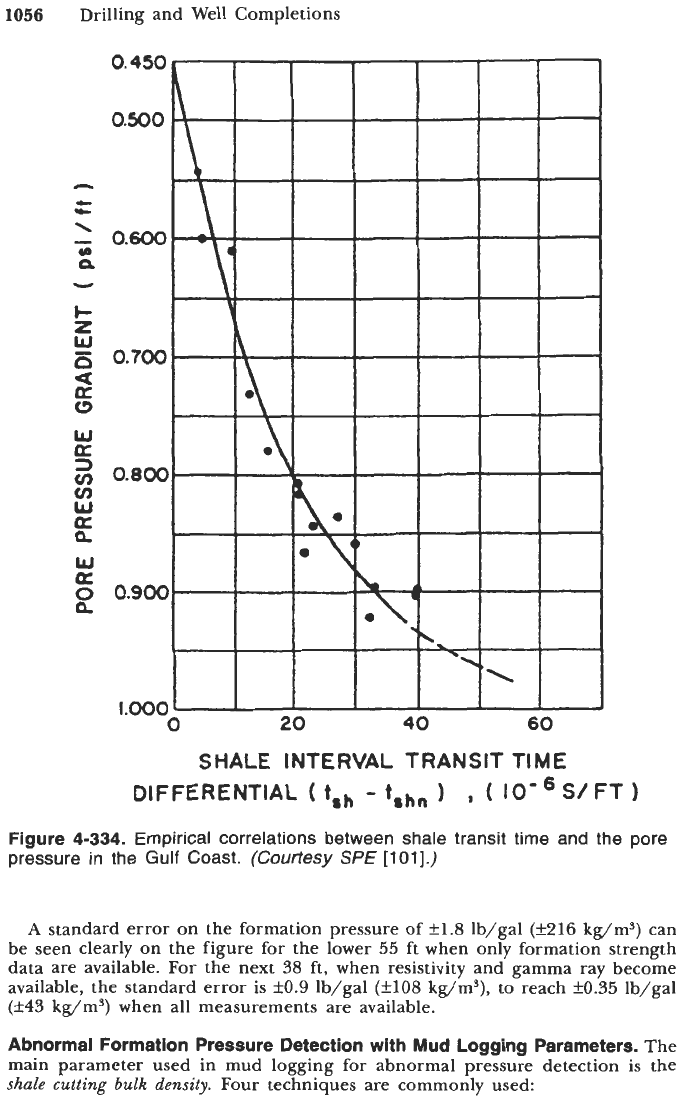
1056
Drilling and Well Completions
SHALE INTERVAL TRANSIT
TIME
DIFFERENTIAL
(t,h
-
trhn
,
(
IO-~SIFT)
Figure
4-334.
Empirical correlations between shale transit time and the pore
pressure in the Gulf Coast.
(Courtesy
SPE
[loll.)
A
standard error on the formation pressure of
k1.8
lb/gal
(f216
kg/m3) can
be seen clearly on the figure for the lower
55
ft when only formation strength
data are available. For the next
38
ft, when resistivity and gamma ray become
available, the standard error is
f0.9
lb/gal
(f108
kg/m5), to reach
k0.35
lb/gal
(f43
kg/m3) when all measurements are available.
Abnormal Formation Pressure Detection
with
Mud Logging Parameters.
The
main parameter used in mud logging for abnormal pressure detection is the
shale
cutting
bulk
density.
Four techniques are commonly used:
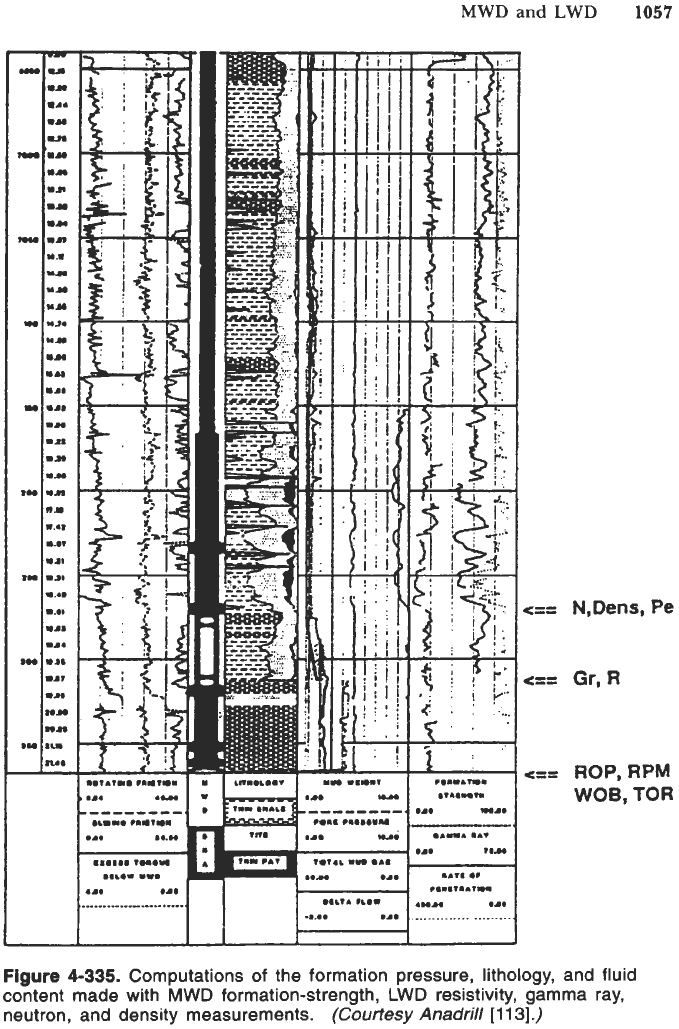
MWD
and
LWD
1057
..OD.
m.v
04.
Ian
.are
w
...
araa1Dn
."..
*a.
......................
e==
N,Dens,
Pe
e==
ROP,RPM
WOB, TOR
Figure
4-335.
Computations of the formation pressure, lithology, and fluid
content made with MWD formation-strength, LWD resistivity, gamma ray,
neutron, and density measurements.
(Courtesy
Anadrill
[113].)
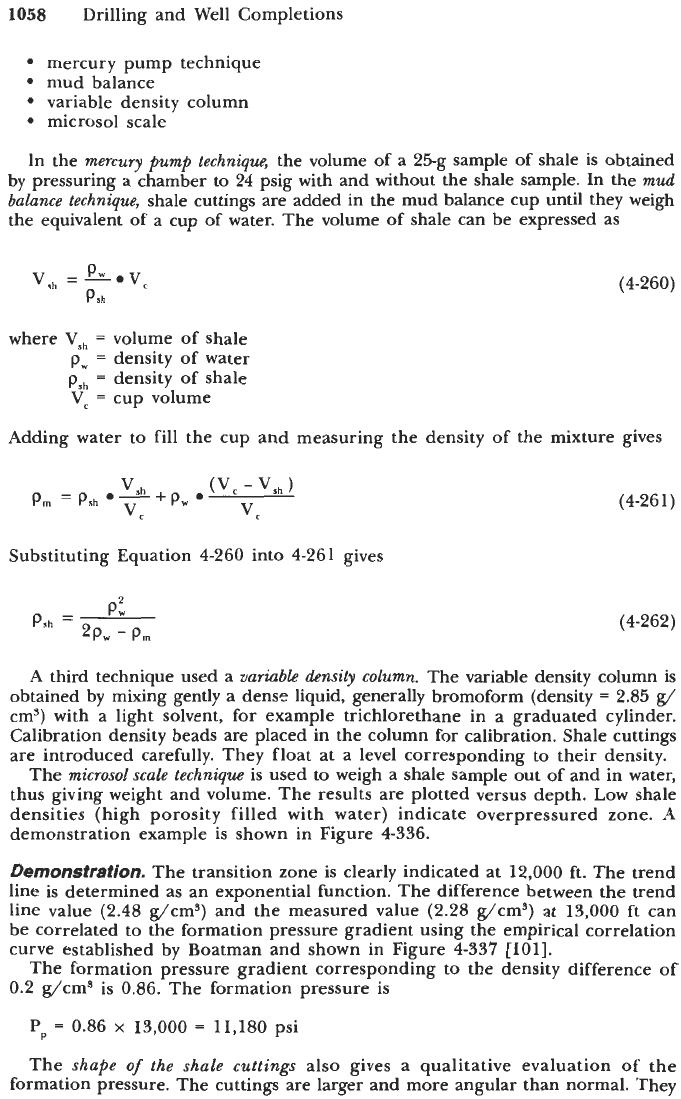
1058
Drilling and Well Completions
mercury pump technique
mud balance
variable density column
microsol scale
In the
mercury pump technique,
the volume of a
25-g
sample of shale is obtained
by pressuring a chamber to
24
psig with and without the shale sample. In the
mud
balance technique,
shale cuttings are added in the mud balance cup until they weigh
the equivalent of a cup of water. The volume of shale can be expressed as
(4-260)
where
Vsh
=
volume of shale
p,
=
density of water
psh
=
density of shale
Vc
=
cup volume
Adding water to fill the cup and measuring the density of the mixture gives
Substituting Equation
4-260
into
4-261
gives
(4-26
1)
(4-262)
A third technique used a
variable density column.
The variable density column is
obtained by mixing gently a dense liquid, generally bromoform (density
=
2.85
g/
cm3) with a light solvent, for example trichlorethane in a graduated cylinder.
Calibration density beads are placed in the column for calibration. Shale cuttings
are introduced carefully. They float at a level corresponding to their density.
The
microsol scale technique
is used to weigh a shale sample out of and in water,
thus giving weight and volume. The results are plotted versus depth. Low shale
densities (high porosity filled with water) indicate overpressured zone. A
demonstration example is shown in Figure
4-336.
Demonstration.
The transition zone is clearly indicated at
12,000
ft. The trend
line is determined as an exponential function. The difference between the trend
line value
(2.48
g/cm3) and the measured value
(2.28
g/cms) at
13,000
ft can
be correlated to the formation pressure gradient using the empirical correlation
curve established by Boatman and shown in Figure
4-337 [loll.
The formation pressure gradient corresponding to the density difference of
0.2
g/cm3 is
0.86.
The formation pressure is
Pp
=
0.86
x
13,000
=
11,180
psi
The
shape
of
the shale cuttings
also gives a qualitative evaluation of the
formation pressure. The cuttings are larger and more angular than normal. They
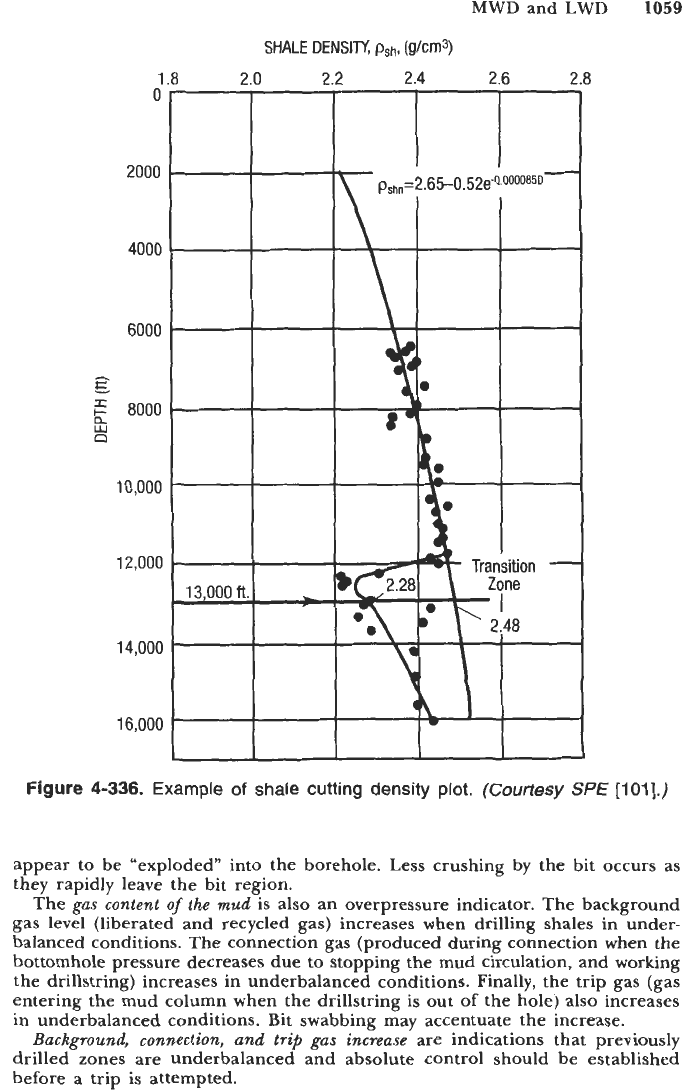
1
0
2000
4000
6000
r“
JZ
8000
ii
8
10,000
12,000
14,000
16,000
.8
2.0
L
-
13,000
it.
L
MWD
and
LWD
1059
SHALE
DENSITY,
Psh,
(g/Cm3)
Figure
4-336.
Example
of
shale cutting
density
plot.
(Courtesy
SPE
[loll.)
appear to be “exploded” into the borehole. Less crushing by the bit occurs as
they rapidly leave the bit region.
The
gas
content
of
the mud
is also an overpressure indicator. The background
gas level (liberated and recycled gas) increases when drilling shales in under-
balanced conditions. The connection gas (produced during connection when the
bottomhole pressure decreases due to stopping the mud circulation, and working
the drillstring) increases in underbalanced conditions. Finally, the trip gas (gas
entering the mud column when the drillstring is out of the hole) also increases
in underbalanced conditions. Bit swabbing may accentuate the increase.
Background, connection, and
trip
gas increase
are indications that previously
drilled zones are underbalanced and absolute control should be established
before a trip
is
attempted.
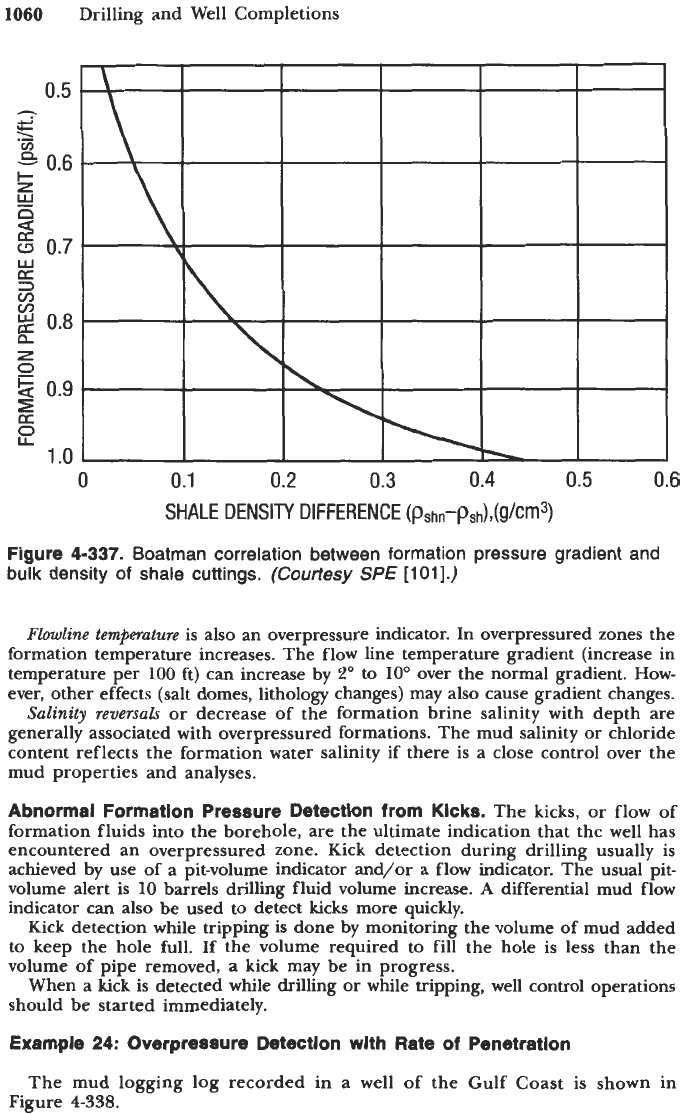
1060
0.5
h
rn
+
E
z
0.6
3
a
0.7
w
CT
3
m
m
P
z
2
0.8
0
k
0.9
ra
9
1
.o
Drilling and Well Completions
0 0.1
0.2
0.3
0.4
0.5
0.6
SHALE DENSITY DIFFERENCE
(pshn-psh),(g/cm3)
Figure
4-337.
Boatman correlation between formation pressure gradient and
bulk density
of
shale cuttings.
(Courtesy SPE
[loll.)
Flowline temperature
is also an overpressure indicator. In overpressured zones the
formation temperature increases. The flow line temperature gradient (increase in
temperature per
100
ft) can increase by
2"
to
10"
over the normal gradient. How-
ever, other effects (salt domes, lithology changes) may also cause gradient changes.
Salinity reversals
or decrease of the formation brine salinity with depth are
generally associated with overpressured formations. The mud salinity or chloride
content reflects the formation water salinity if there is a close control over the
mud properties and analyses.
Abnormal Formation Pressure Detection
from
Kicks.
The kicks, or flow of
formation fluids into the borehole, are the ultimate indication that the well has
encountered an overpressured zone. Kick detection during drilling usually is
achieved by use
of
a pit-volume indicator and/or
a
flow indicator. The usual pit-
volume alert is
10
barrels drilling fluid volume increase.
A
differential mud flow
indicator can also be used to detect kicks more quickly.
Kick detection while tripping is done by monitoring the volume of mud added
to keep the hole full. If the volume required to fill the hole is less than the
volume of pipe removed,
a
kick may be in progress.
When
a
kick is detected while drilling or while tripping, well control operations
should
be
started immediately.
Example
24:
Overpressure Detection
wlth
Rate
of
Penetration
Figure
4-338.
The mud logging log recorded in a well of the Gulf Coast is shown in
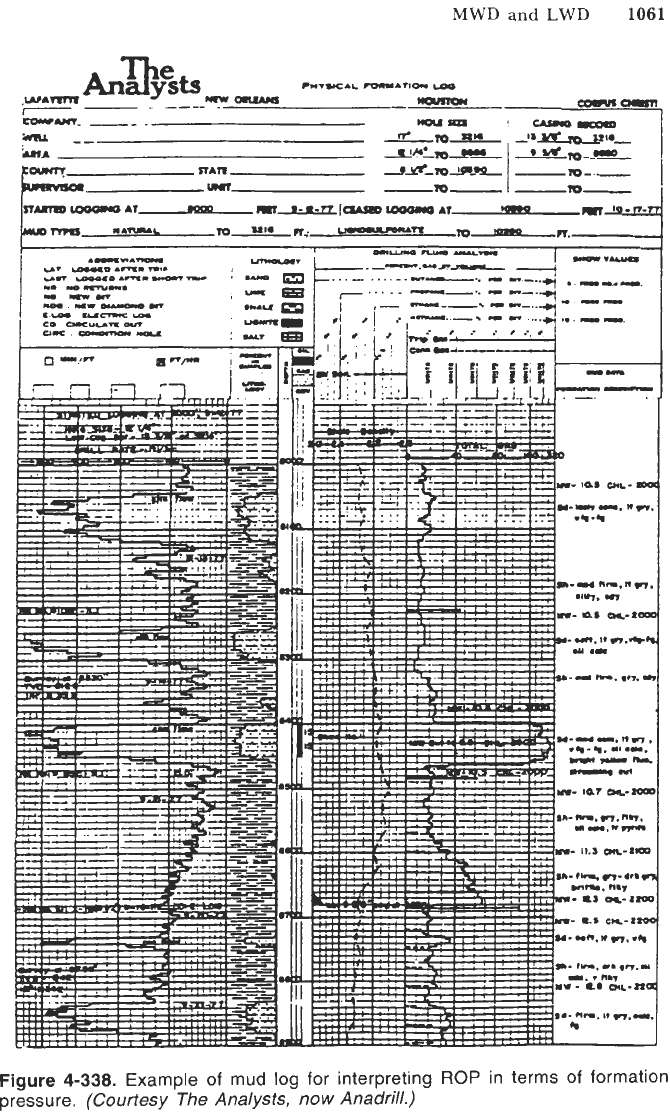
MWD
and
LWD
1061
Figure
4-338.
Example of
mud
log for interpreting
ROP
in terms of formation
pressure.
(Courtesy The Analysts, now Anadrill.)
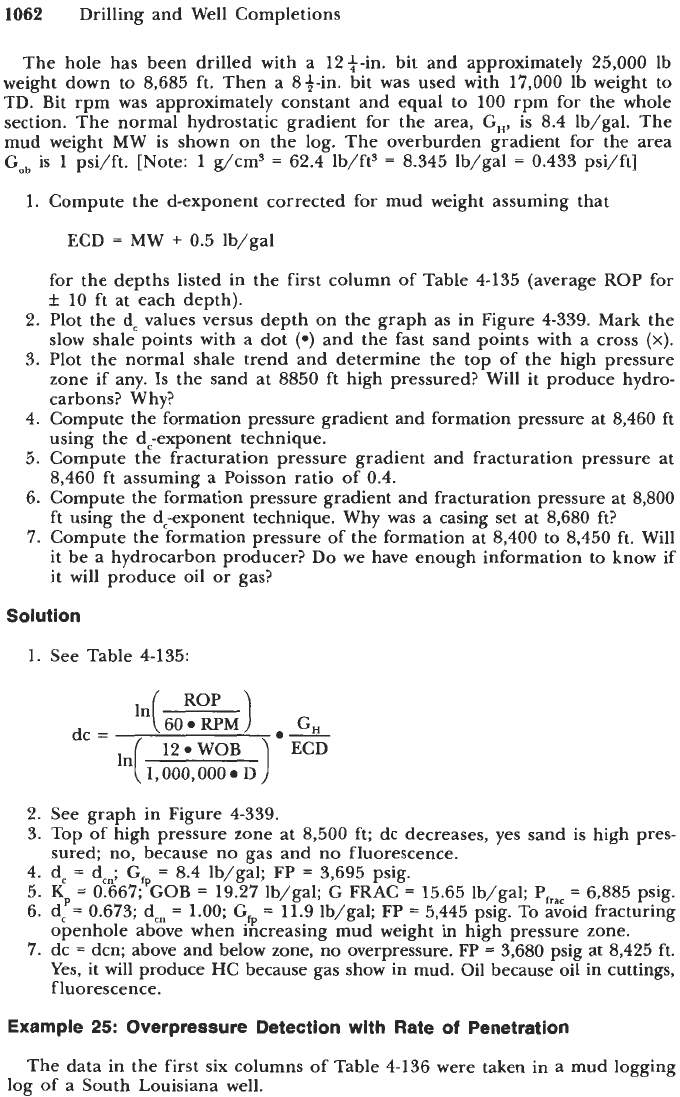
1062
Drilling and Well Completions
The hole has been drilled with a
12$-in.
bit and approximately
25,000
Ib
weight down to
8,685
ft. Then a 84411. bit was used with
17,000
lb weight to
TD. Bit rpm was approximately constant and equal to
100
rpm for the whole
section. The normal hydrostatic gradient for the area,
G,,
is
8.4
lb/gal. The
mud weight MW is shown on the log. The overburden gradient for the area
Gob
is
1
psi/ft. [Note:
1
g/cm3
=
62.4
lb/ft3
=
8.345
Ib/gal
=
0.433
psi/ft]
1.
2.
3.
4.
5.
6.
7.
Compute the d-exponent corrected for mud weight assuming that
ECD
=
MW
+
0.5
lb/gal
for the depths listed in the first column of Table
4-135
(average ROP for
f.
10
ft at each depth).
Plot the dc values versus depth on the graph as in Figure
4-339.
Mark the
slow shale points with a dot
(e)
and the fast sand points with a cross
(x).
Plot the normal shale trend and determine the top of the high pressure
zone if any.
Is
the sand at
8850
ft high pressured? Will it produce hydro-
carbons? Why?
Compute the formation pressure gradient and formation pressure at
8,460
ft
using the d;exponent technique.
Compute the fracturation pressure gradient and fracturation pressure at
8,460
ft assuming a Poisson ratio of
0.4.
Compute the formation pressure gradient and fracturation pressure at
8,800
ft using the d;exponent technique. Why was a casing set at
8,680
ft?
Compute the formation pressure of the formation at
8,400
to
8,450
ft. Will
it be a hydrocarbon producer? Do we have enough information to know
if
it will produce oil or gas?
Solution
1.
See Table
4-135:
dc
=
G,
ECD
2.
See graph in Figure
4-339.
3.
Top of high pressure zone at
8,500
ft; dc decreases, yes sand is high pres-
4.
dc
=
do;
G,
=
8.4
lb/gal; FP
=
3,695
psig.
5.
KP
=
0.667;
GOB
=
19.27
lb/gal;
G
FRAC
=
15.65
lb/gal; Pfrac
=
6,885
psig.
6.
dc
=
0.673;
dCn
=
1.00; G,
=
11.9
lb/gal; FP
=
5,445
psig. To avoid fracturing
openhole above when increasing mud weight
in
high pressure zone.
7.
dc
=
dcn; above and below zone, no overpressure. FP
=
3,680
psig at
8,425
ft.
Yes,
it
will produce HC because gas show in mud. Oil because oil in cuttings,
fluorescence.
sured; no, because no gas and no fluorescence.
Example
25:
Overpressure Detection with Rate
of
Penetration
The data in the first six columns of Table
4-136
were taken in a mud logging
log of
a
South Louisiana well.
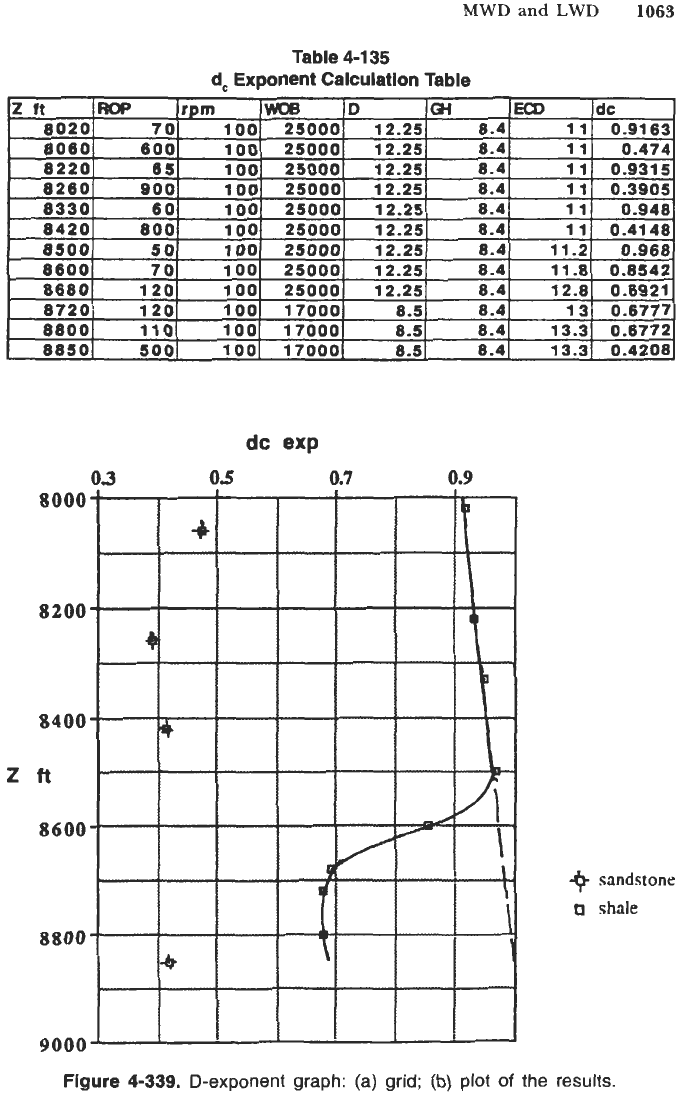
MWD
and
LWD
1063
Table 4-1
35
d,
Exponent Calculation Table
Z
03
dc
exp
os
0.7
0.9
0
sandstone
a
shale
l"""
Figure 4-339.
D-exponent graph:
(a)
grid;
(b)
plot
of
the results.
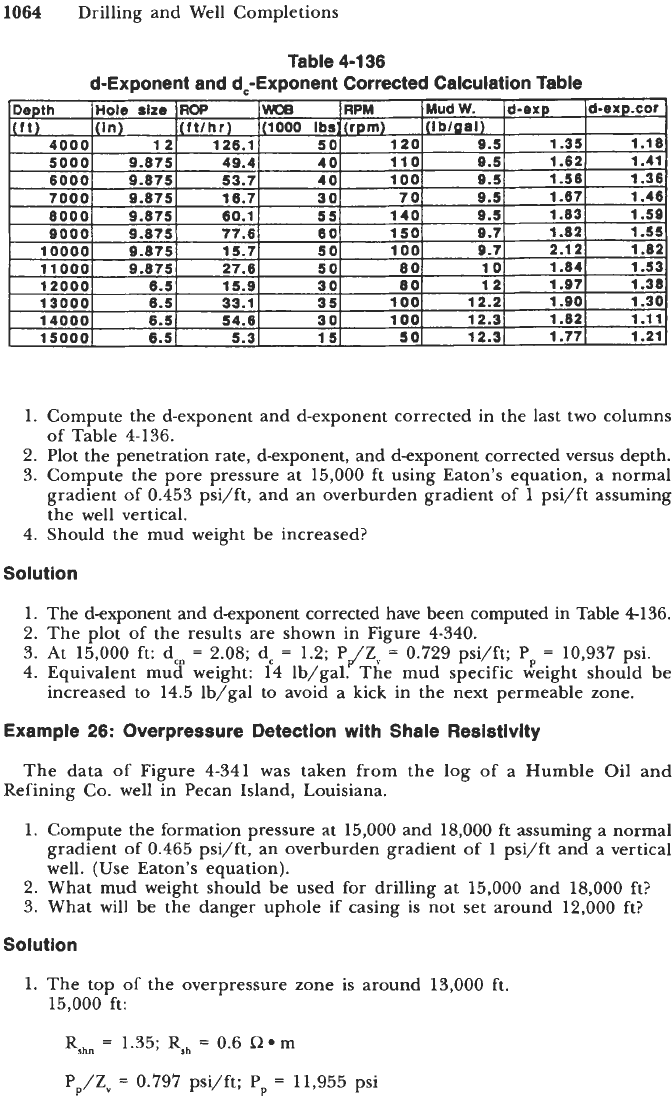
1064
Drilling and Well Completions
Table
4-1
36
d-Exponent and d,-Exponent Corrected Calculation Table
Compute the d-exponent and d-exponent corrected in the last two columns
of Table
4-136.
Plot the penetration rate, d-exponent, and dexponent corrected versus depth.
Compute the pore pressure at
15,000
ft using Eaton’s equation, a normal
gradient of
0.453
psi/ft, and an overburden gradient
of
1
psi/ft assuming
the well vertical.
Should the mud weight be increased?
Solution
1.
The d-exponent and dexponent corrected have been computed in Table
4136.
2.
The plot of the results are shown in Figure
4-340.
3.
At
15,000
ft: dcn
=
2.08;
dc
=
1.2;
P$Z,
=
0.729
psi/ft; Pp
=
10,937
psi.
4.
Equivalent mud weight:
14
Ib/gal. The mud specific weight should be
increased to
14.5
Ib/gal to avoid a kick in the next permeable zone.
Example
26:
Overpressure Detection with Shale Resistivity
The data of Figure
4-341
was taken from the log of a Humble Oil and
Refining Co. well in Pecan Island, Louisiana.
1.
Compute the formation pressure at
15,000
and
18,000
ft assuming a normal
gradient
of
0.465
psi/ft, an overburden gradient of
1
psi/ft and a vertical
well.
(Use
Eaton’s equation).
2.
What
mud
weight should be used for drilling at
15,000
and
18,000
ft?
3.
What will be the danger uphole if casing is not set around
12,000
ft?
Solution
1.
The top of the overpressure zone is around
13,000
ft.
15,000
ft:
Rshn
=
1.35;
R,
=
0.6
L2.m
Pp/Zv
=
0.797
psi/ft; Pp
=
11,955
psi
